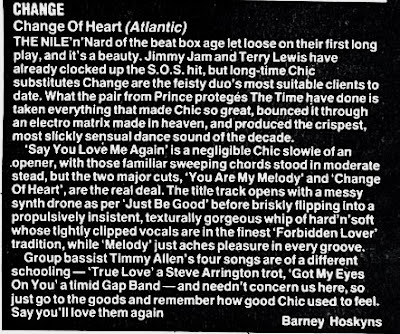In the piece on Chic and Sister Sledge et al, I note of Nile Rodgers & Bernard Edwards's songwriting:
"Chic favored chord changes sublimely poised between happy and sad while the choruses were staccato, the spaced-out notes seemingly plotted on graph paper."
Listening to all the ChicOrg classic-era tunes, it struck me that Nile Rodgers & Bernard Edwards were among the pioneers - perhaps the pioneers - of a stylistic feature of writing during the postdisco era, something I'd noted earlier in the year when listening to a ton of Eighties boogie and club tracks. It's particularly pronounced in the songwriting of Jimmy Jam & Terry Lewis for acts like The S.O.S. Band.
On Dissensus I observed:
One thing I've noticed recently listening to 80s club faves, is that a lot of postdisco / boogie tunes have this thing where the chorus is rectilinear - regular and spaced out notes - which creates a delicious tension with the grooviness of the music. The verse melodies tend to move in this more fluidly shimmying soulful way.
The choruses sound clipped - there don't tend to be long held notes, and there's rarely melisma or trills or any kind of flourish. Instead it's all about precision and staccato starkness.
Odyssey's "Inside Out" is a good example - and a wonderful song / vocal performance, from Lillian Lopez (with this ever-so slightly harsh nasally timbre and sort of yearningly imperious tone).
(Also the lyric is a bit peculiar, if you pay attention to it - "When you're lying in her bed / And you're in her arms instead of my love /As you feel her tightening grip...." Beg pardon ooer missus .... and then "And she's always on that phone / And you just don't think that you got the strength to fight it" - the fantasmic scenario dreamed of by the rival-in-love singing the song seems to be "hold on, I'm coming to your rescue", which may not be the male's feeling about the situation at all)
Cheryl Lynn's marvelous "Encore" (written and produced by Jam & Lewis) is another prime case, with the spacing-out effect exacerbated by breaking up the chorus so that it's a sort of lurching back and forth between two voices (Cheryl and a backing singer, or it is Cheryl multitracked?).
Change's Chic-like "Change of Heart" (written, arranged and produced by Jam & Lewis) has the melodic spacing in the chorus in full effect. But the verses are also quite rectilinear (not sure if that's the right word but I'm sticking with it). It's a very controlled sounding record.
Melodically "The Finest" has that "plotted out on graph paper" quality - and Mary Davis's singing is just as restrained and near-formal as the melody is - which suits the kind of amorous constraints under which the song's character lives, a satellite of love.
But then that exquisitely prim poise is blown with a horrible section that's all melismatic and oversouled, shattering the mood completely.
Apart from that thankfully brief excrescence, the whole of "The Finest" from the drum machine rhythm-track upwards, feels like a grid - or like a set of grids superimposed over each other.
And of course nuumologists need no reminding what eternal anthem it led to...
Jam & Lewis have similar things going on with certain Janet Jackson tunes and also Human League's "Human".
Rewinding to a few years earlier - Kool and the Gang's "Get Down On It" - I remember at the time this originally came out thinking that it had a curious quality of geometry, an oddly orderly symmetry.... but in this case that tension, the play of rigidity against loose 'n' groovy, is at work at all levels of the instrumentation not just the vocal melody.
A recurrence of that kind of feel - spaced-out, tautly controlled, geometric - comes in the late '90s with Timbaland, especially the Aaliyah tunes. Here the spacing is even more strikingly stark, huge gaps in the drum programming. Aaliyah often sings as if she's tip-toeing, the voice padding across the stave with a feline wariness
Bringing it around to where we started, I discover that Timbaland engineer Jimmy Douglass actually produced Odyssey's "Inside Out" (one of his other clients around that time was Gang of Four for Solid Gold). "Inside Out" was actually written by Jesse Rae, a Scotsman so steeped in funk and R&B that he could fluently write in the idiom and pass for the real thing (in the late 80s I interviewed him about his own excellent music).
^^^^^^^^^^^^^^^^^^^^^^^^^
Here's a rather good white copy of postdisco geometrics - the tune feels like glistening planes intersecting in space, like a mobile made of colored glass

2 comments:
The precision and grid-like nature of the '80s tracks you mention would be the consequence of MIDI sequencing, no? Re: post-disco boogie, quality noticeably declines outside the usual major labels and the big players on the scene such as Prelude and West End (and I wish it didn't cos I love it).
no i think it's a property of discofunk before MIDI becomes a big thing. Chic Organisation has it from late '70s. it's a style of songwriting more than anything, and also of singing - more restrained and 'cool', not melismatic showing off. perhaps it's post-soul.
Post a Comment